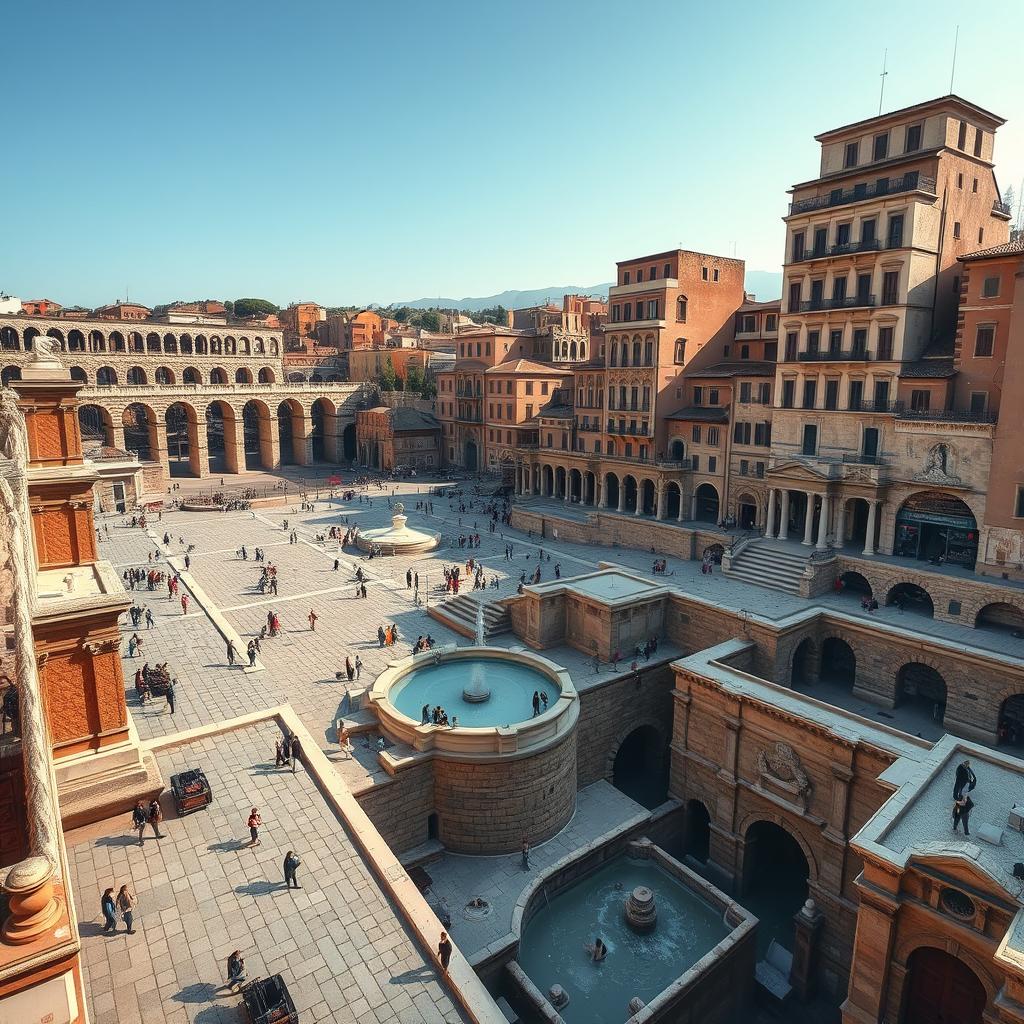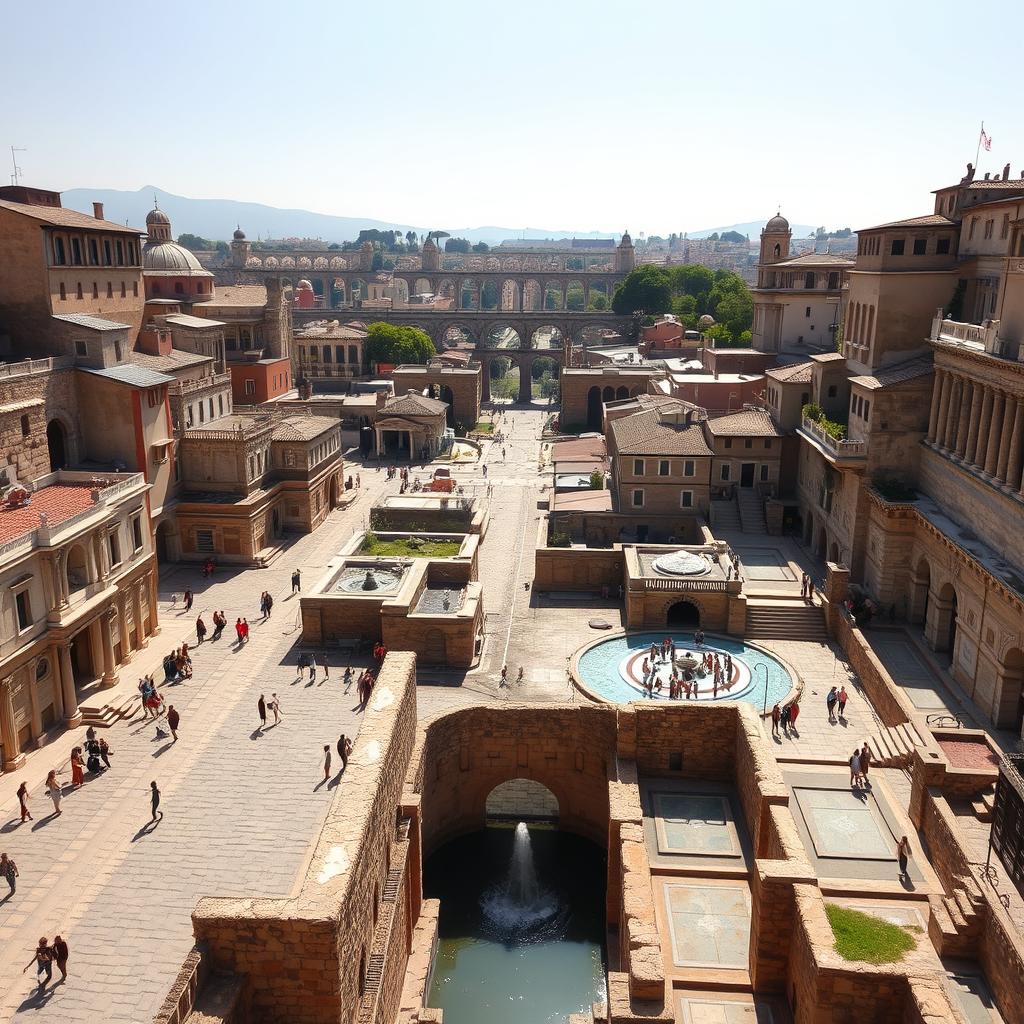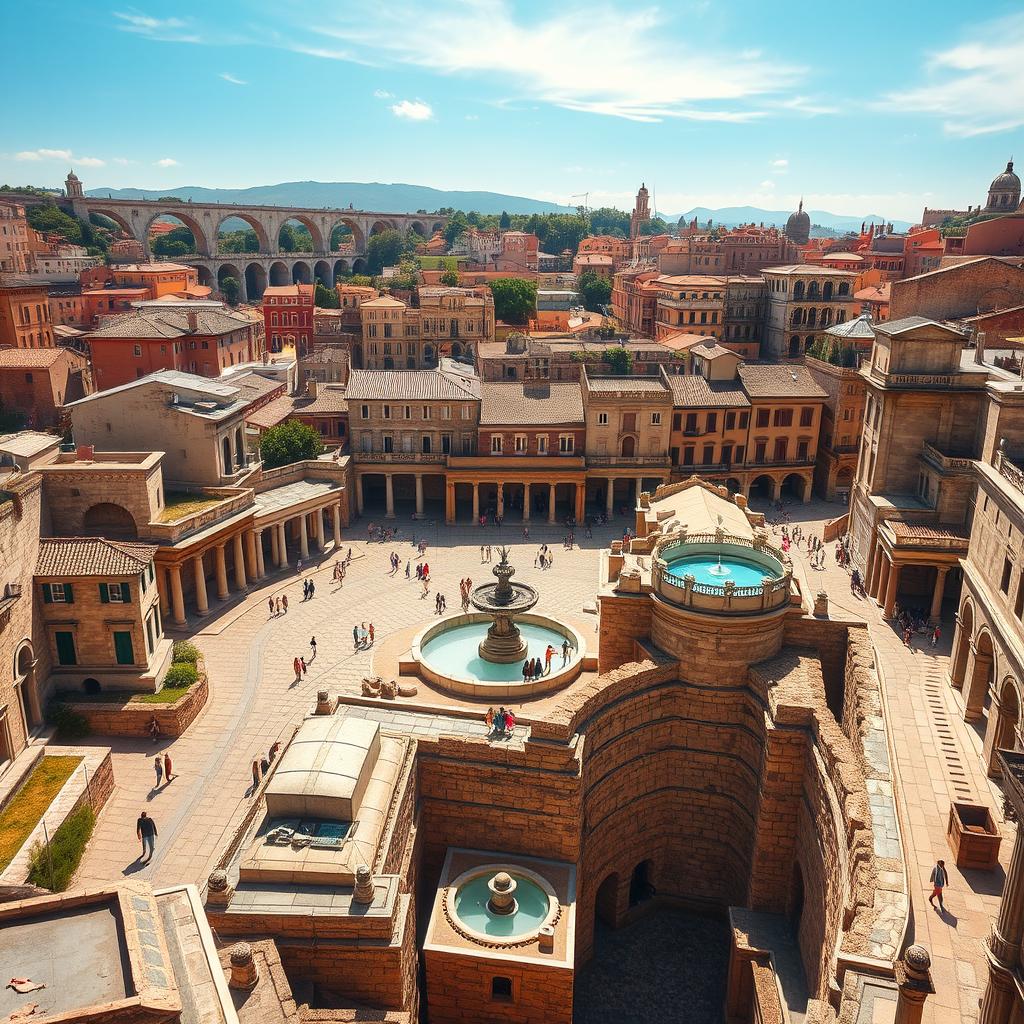When Rome Built It Right: Ancient Solutions to Modern Urban Chaos
The greatest urban planning revolution in history didn’t happen in the gleaming skyscrapers of Dubai or the eco-friendly districts of Copenhagen. It unfolded over two thousand years ago, when a civilization without computers, electricity, or modern materials created cities that functioned better than many of ours do today.
As our modern metropolises struggle with traffic congestion, water management, and waste disposal, the ghosts of Roman innovation whisper solutions across millennia. What if the answers to our most pressing urban challenges were perfected long before the first automobile ever rumbled down a city street?
The concrete beneath Roman feet has outlasted empires. Their water systems delivered more fresh water to ordinary citizens than many developing cities manage today. Their street designs created walkable, functional neighborhoods that modern urban planners spend fortunes trying to recreate. These weren’t coincidences—they were the result of a sophisticated approach to urban planning that balanced practicality, governance, and quality of life in ways we’ve struggled to match.
While we tout smart cities and technological solutions, we often overlook how an ancient civilization without these advantages created urban environments that served millions efficiently. The Roman approach wasn’t just advanced for its time—in many ways, it remains unmatched in ours.
The Roman City: A Marvel of Practical Engineering
Imagine standing at an intersection in ancient Rome around 100 CE. Before you stretches a grid of streets, paved with fitted stones that remain perfectly functional after seasonal flooding. Water flows through an intricate system of pipes to public fountains, where citizens gather to collect fresh, clean water delivered from mountains miles away. Beneath your feet runs a network of sewers, carrying waste safely away from the population center. The buildings around you, from multi-story apartment blocks to public baths, stand as testaments to engineering principles that would not be rediscovered for centuries.
This wasn’t a utopian vision—it was the everyday reality for millions of people across the Roman Empire. While medieval European cities later devolved into disease-ridden cesspools where raw sewage ran down the middle of muddy streets, Romans had already solved these problems through systematic urban planning.
The genius of Roman urban design lay in its fundamental understanding that cities are complex systems requiring integrated solutions. They didn’t just build impressive monuments; they created functional urban environments where everyday life could flourish. This holistic approach stands in stark contrast to the often fragmented, reactionary urban development we see today, where traffic planning, water management, housing, and public spaces are frequently addressed in isolation rather than as interconnected elements of a single system.

Water Management: The Lifeblood of Civilization
Perhaps nowhere is Roman ingenuity more evident than in their revolutionary approach to water. Long before modern concerns about water security and management became critical topics in urban planning, Romans had developed systems that delivered abundant, clean water to their cities with remarkable efficiency.
The iconic aqueducts represent just the most visible component of a sophisticated water infrastructure. These engineering marvels transported water from distant sources to urban centers using nothing but gravity. The gradient of these structures was carefully calculated to maintain a consistent, gentle flow—typically dropping just one foot for every 300 feet of distance. This precision required extraordinary surveying skills in an age without modern instruments.
Once water reached the city, it entered distribution tanks (castellum aquae) before flowing through a network of lead pipes to public fountains, baths, and sometimes private homes. The system was designed with redundancies and overflow mechanisms to handle fluctuations in supply and demand. Public fountains flowed continuously, ensuring fresh water and helping flush the street drainage systems.
Today, as cities worldwide face water crises and aging infrastructure, the Roman water system offers timeless principles worth reconsidering. Their approach prioritized public access, system redundancy, and maintenance—all critical factors that modern water systems sometimes overlook in favor of quick fixes or privatized solutions.
The Roman system delivered an estimated 200 million gallons of water daily to the city of Rome at its height—roughly 200 gallons per person. For comparison, modern Rome provides about 150 gallons per person daily, despite all our technological advantages. What makes this even more remarkable is that the Roman system operated almost entirely through passive means, requiring minimal ongoing energy input.
The Grid and Beyond: Urban Layout as Social Engineering
Roman city planning went far beyond basic utility. The layout of streets and neighborhoods reflected a sophisticated understanding of how urban form influences social function and civic identity. The classic Roman grid wasn’t implemented merely for ease of navigation—it represented an organizational principle that facilitated governance, commerce, and community.
At the heart of the Roman city lay the forum—a central public space that combined governmental, religious, commercial, and social functions. This multi-use approach created vibrant urban centers where different aspects of civic life converged and reinforced each other. The forum wasn’t just a place to shop or worship; it was where citizens encountered the full spectrum of urban life.
Radiating from this center, Roman cities typically followed orthogonal grid patterns with main thoroughfares (cardo and decumanus) intersecting at the center. This organization allowed for efficient movement, simplified property division, and facilitated the provision of services. Yet Romans were also pragmatic, adapting their ideal plans to topographical realities and pre-existing settlements.
Modern urban planners have rediscovered many principles of Roman city design through concepts like new urbanism and transit-oriented development. The walkable scale, mixed-use zoning, and emphasis on public spaces that define these modern movements would have been immediately recognizable to a Roman urban planner.
Perhaps most significantly, Roman cities were designed with a clear understanding of the relationship between built environment and social cohesion. Public spaces weren’t afterthoughts but integral components of urban life, fostering the community engagement that sustained their civilization. As our modern cities struggle with alienation and social fragmentation, this aspect of Roman planning offers particularly valuable insights.

Infrastructure That Stands the Test of Time
The physical durability of Roman construction remains one of its most remarkable aspects. Roman concrete structures have endured for millennia, often outlasting modern constructions by centuries. The Pantheon in Rome, completed around 126 CE, still stands with its unreinforced concrete dome intact—the largest such structure in the world for over 1,300 years. Modern concrete typically begins deteriorating within decades, while Roman marine concrete actually strengthens over time through interaction with seawater.
This extraordinary durability wasn’t accidental. Roman builders developed concrete (opus caementicium) formulations specifically suited to different applications and environments. They understood that infrastructure represents a multi-generational investment, not a temporary solution.
Beyond material science, Romans brought this same long-term perspective to all aspects of infrastructure planning. Their roads—over 250,000 miles of them across the empire—were built with multiple layers for drainage and durability. Many remained in use for centuries after the empire’s fall, and some Roman road routes still form the basis of modern highways.
Roman sewers, like the magnificent Cloaca Maxima in Rome, were constructed at scales that allowed for growth and with materials that have permitted parts of the system to remain functional after more than 2,500 years. This forward-thinking approach contrasts sharply with modern infrastructure that often fails to anticipate future needs or prioritize longevity.
In an age of tight budgets and short-term thinking, the Roman commitment to building for posterity offers a powerful counterexample. Their infrastructure wasn’t just built to solve immediate problems but to serve generations yet unborn—a perspective increasingly rare in our quarterly-report-driven world.
Public Health by Design: The First Urban Wellness Systems
Perhaps the most progressive aspect of Roman urban planning was its implicit understanding of public health principles—long before germ theory or modern medicine. Romans intuitively grasped connections between urban design and human wellbeing that would not be scientifically validated until the 19th century.
The Roman sewer system represented an unprecedented public health intervention. By removing waste from population centers, these systems dramatically reduced exposure to pathogens. The Cloaca Maxima and its successors transformed Rome from a disease-prone settlement to a metropolis capable of supporting a dense population with relatively low mortality rates compared to later medieval cities.
The Roman bath complex (thermae) further demonstrates their understanding of wellness infrastructure. These facilities weren’t just luxuries but essential public health amenities that provided hygiene services, exercise spaces, and social interaction. The baths operated on a sliding fee scale, with many offering free access during certain hours, ensuring that basic hygiene services were available to citizens across social classes.
Equally important was the Roman approach to urban density. Unlike the overcrowded, airless slums that would characterize many industrial-era cities, Roman apartment buildings (insulae) were regulated for structural safety and often featured courtyards for light and ventilation. Height restrictions (typically 70 feet under Augustus) prevented the dark, narrow streets that plagued later cities.
As modern cities confront challenges from airborne pandemics to the mental health impacts of urban design, the Roman integration of public health considerations into basic urban planning offers valuable lessons. Their approach recognized that city design and public health were inseparable concerns—a connection we’ve often lost in our more specialized, siloed planning processes.

Before and After: The Urban Planning Revolution
Before the Roman urban planning revolution, cities worldwide typically developed organically, with minimal systematic infrastructure or centralized planning. Water came from local wells or rivers, often contaminated by nearby waste disposal. Streets followed topography and historical pathways rather than efficient designs. Building practices varied widely in quality and safety. Public health was an alien concept, with disease accepted as an inevitable aspect of urban life.
After Roman innovations, cities within their influence gained integrated systems addressing water supply, waste management, transportation, public spaces, and disaster resilience. These weren’t separate initiatives but components of a holistic approach to urban functionality. The Roman model established expectations that would influence urban development for millennia.
The bridge between these two worlds wasn’t simply technology but a fundamental shift in thinking about what cities could and should be. Romans approached urban development as a systematic endeavor requiring coordination, forward planning, and public investment. They recognized cities as engines of civilization that functioned best when designed deliberately rather than allowed to evolve haphazardly.
This conceptual revolution may be the most valuable Roman legacy for contemporary urban challenges. While specific Roman techniques may not always transfer directly to modern contexts, their systematic approach to urban problems offers a powerful framework for addressing today’s complex urban challenges.
From Ancient Wisdom to Modern Application
The relevance of Roman urban planning to contemporary challenges becomes clear when we examine specific parallels. Consider water security—a growing crisis in cities worldwide. Romans addressed this through redundant supply systems, public access guarantees, and infrastructure built to last generations. These principles remain valid regardless of whether we’re building aqueducts or desalination plants.
Or consider transportation networks. Roman roads prioritized connectivity, durability, and standardization across vast territories. As we develop transportation systems for the next century, these same principles apply whether we’re planning highways or hyperloops.
The Roman approach to public space offers perhaps the most directly applicable lessons. Their forums, baths, and markets created multi-functional civic centers that fostered community interaction across social boundaries. As cities combat isolation and social fragmentation, the deliberate creation of shared public realm remains as vital as it was two millennia ago.
Even Roman administrative innovations offer relevant models. Their establishment of building codes, infrastructure maintenance systems, and urban governance structures created frameworks for managing complex urban environments that remain instructive. The office of aedile—responsible for street maintenance, water supply, and public buildings—represents one of history’s first dedicated urban management positions.
The point isn’t that we should replicate Roman techniques exactly, but that we should approach urban challenges with the same integrated, long-term perspective that made their solutions so effective. In many cases, this means rediscovering principles that have been obscured by our tendency toward specialization and short-term thinking.

Why We Forgot What Romans Remembered
The decline of Roman urban standards following the empire’s fragmentation represents one of history’s great steps backward in quality of life. European cities would not regain Roman levels of infrastructure and public health until the 19th century—a regression lasting over a millennium. Understanding this decline offers insights into our own urban vulnerabilities.
The loss of Roman urban knowledge wasn’t primarily about forgotten technology. Rather, it reflected the dissolution of systems for maintaining and replicating complex infrastructure. As centralized authority weakened, the organizational capacity to maintain aqueducts, sewers, and public facilities eroded. Individual techniques remained known, but the systematic application of these techniques at urban scale became impossible without supportive governance structures.
This historical lesson holds particular relevance today as cities face challenges from climate change to infrastructure deterioration. Technical solutions matter, but equally important are the governance systems that implement and maintain them across generations. The most brilliant urban innovations become meaningless without institutional frameworks to sustain them.
Roman urban resilience derived not just from engineering excellence but from administrative systems that valued and maintained that excellence over time. Their urban achievements were as much organizational as technical—a crucial insight for cities navigating contemporary challenges.
The Future of Cities May Look Like the Past
As we confront unprecedented urban challenges, from climate adaptation to demographic shifts, the Roman example offers something more valuable than specific techniques: it demonstrates that fundamentally better approaches to urban development are possible—because they’ve been achieved before.
Many principles of sustainable urban development currently being “discovered” would have been familiar to Roman planners: passive climate management, walkable neighborhoods, mixed-use development, water-sensitive design, and infrastructure built for generations rather than budget cycles. The Romans implemented these principles not out of environmental consciousness but from practical understanding of what makes cities function effectively over time.
Perhaps the most important lesson from Roman urban planning is that truly revolutionary improvements in urban life require integrated approaches addressing multiple systems simultaneously. Roman success came not from solving individual problems in isolation but from recognizing the interconnectedness of urban challenges.
As we seek solutions to traffic congestion, housing affordability, climate resilience, and social fragmentation, the Roman example suggests that these issues cannot be effectively addressed separately. They require the kind of holistic urban vision that turned a collection of hills beside the Tiber into the ancient world’s greatest metropolis.
Rediscovering Ancient Wisdom for Modern Cities
The urban planning revolution we need today isn’t necessarily about new technologies or techniques. It may instead involve rediscovering principles that Romans understood intuitively: that cities function best when planned comprehensively, built durably, and managed for public benefit rather than short-term gain.
This doesn’t mean romanticizing the past or ignoring Roman failures. Their cities had significant problems, from fire vulnerability to social inequities. But the Romans’ willingness to tackle urban challenges systematically and with multigenerational perspective remains profoundly relevant in our age of quick fixes and siloed expertise.
As we stand at a critical juncture in urban development worldwide, with unprecedented urbanization occurring alongside climate change and technological transformation, the Roman example offers both practical insights and philosophical inspiration. Their achievements remind us that cities can be dramatically improved through deliberate design and sustained commitment.
The most fitting tribute to Roman urban genius isn’t preservation of their ruins but application of their principles. When we build infrastructure to last centuries rather than decades, when we design public spaces that foster community rather than commerce alone, when we approach urban challenges with integrated rather than fragmented solutions—we honor the revolution they began and advance it for future generations.
In the end, the most remarkable aspect of Roman urban planning may be how much we still have to learn from it. The questions they answered through practical innovation—how to supply clean water to millions, how to create efficient transportation networks, how to manage waste at urban scale—remain central challenges for cities worldwide. Their solutions, adapted to modern contexts and technologies, offer pathways to urban environments that are not just functional but truly civilized.
The revolution in urban planning that nobody talks about isn’t just history—it’s a blueprint for possibilities that await rediscovery. The Romans built cities that functioned better in many ways than our own, without our technological advantages. Imagine what we might achieve by combining their systemic wisdom with our modern capabilities. The cities that could result wouldn’t just be smart—they would be worthy of the civilization we aspire to become.

